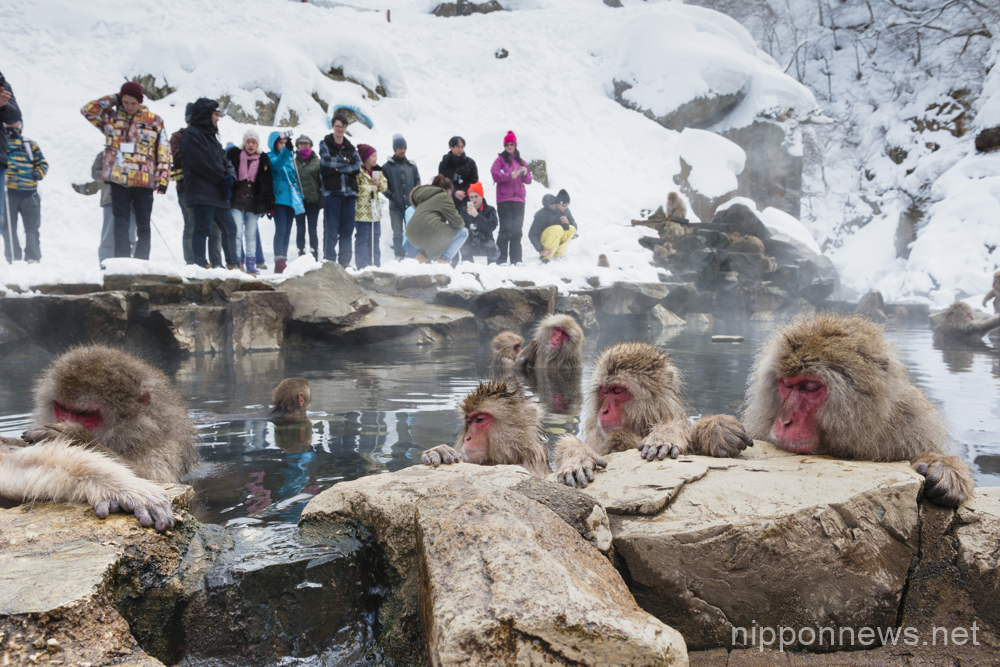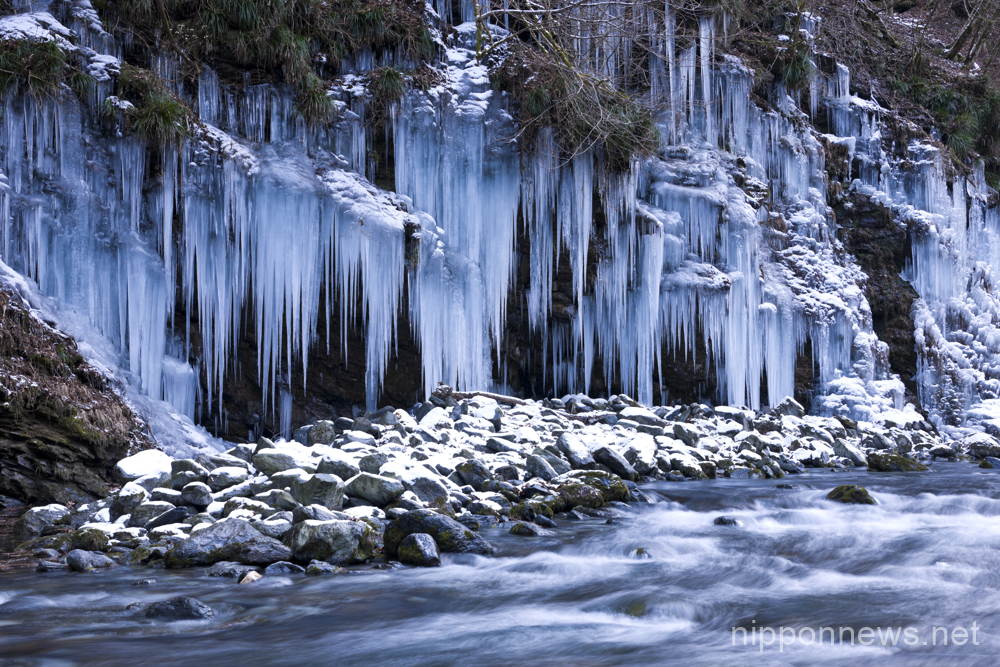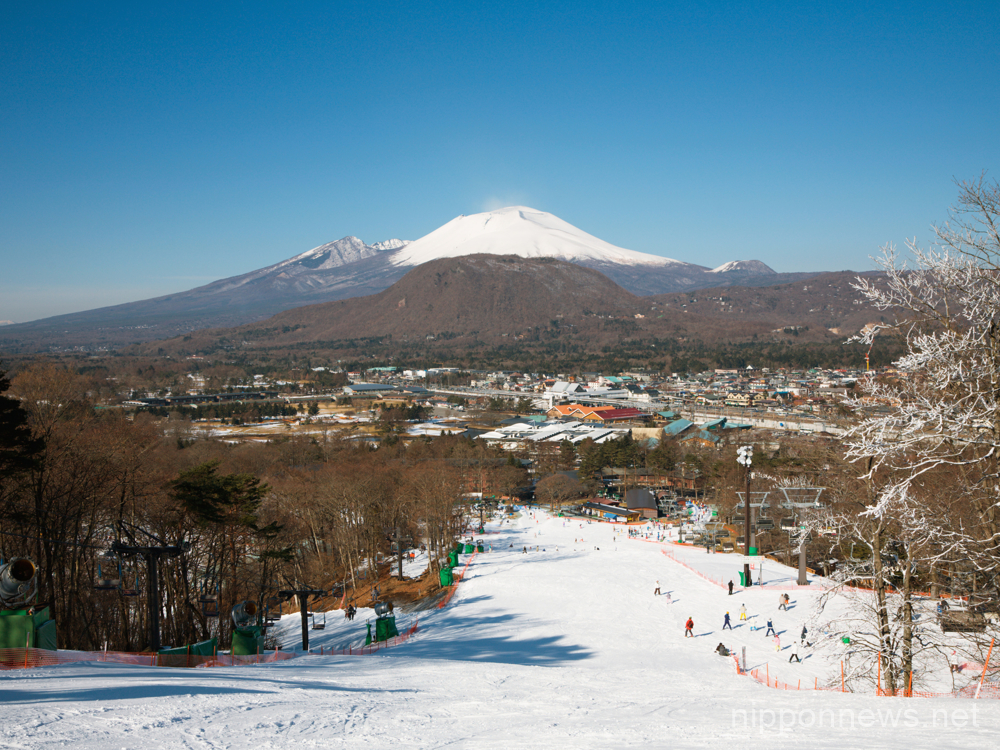Winter in Japan: Where to visit and What to do
Are you planning a trip to Japan during the winter season? We at Afloimages have compiled a list of top winter destinations in Japan. This blog post showcases the must-see locations, which you can see exclusively during the winter time. We hope you can warm up to these beautiful winter destinations on your itinerary to Japan.
Winter in Japan is a unique and beautiful experience, with its snow-covered landscapes, traditional winter festivals, and hot springs. It is a season that many people look forward to, as it offers a variety of activities such as skiing and snowboarding, onsen-hopping, temple and garden visiting, and traditional winter festivals.
Hokkaido Open-air bath and tub (Photo By Masami Goto/Aflo Images)
In the northern regions of Japan, such as Hokkaido, the snowfall can be heavy and the temperatures can drop below freezing, making it a popular destination for winter sports. In the central and southern regions of Japan, the snowfall is not as heavy, but it is still a beautiful season with its winter illuminations and traditional festivals.
Keep reading to discover our top picks to enjoy winter in Japan!
Jigokudani Yaen-koen Park (Nagano Prefecture)
Snow Monkeys bathing in a hot spring at Jigokudani Yaen-koen (Photo By Aflo Images)
Jigokudani Yaen-koen (“Hell Valley” in Japanese) is one of Japan’s most famous destinations during winter, located in Nagano Prefecture. The park is famous for its population of wild Japanese macaques, also known as “snow monkeys,” that can be seen bathing in the park’s hot springs.
The park is open year-round, but the best time to visit is during the winter when the monkeys are most active in the hot springs. It is important to note that the park is in a natural environment and the monkeys are wild animals, so visitors are strongly advised to follow the park’s rules.
Jigokudani Yaen-koen is a great place to visit if you are interested in nature and wildlife, and a unique and rare opportunity to see wild monkeys in a natural setting and to observe their behavior in close proximity.
Browse our collection of Jigokudani Yaen-koen Park images here.
Shirakawago Village (Gifu Prefecture)
Shirakawago village in the snow (Photo By Nobuaki Sumida/Aflo Images)
Located in Gifu Prefecture, Shirakawago was declared a UNESCO World Heritage Site in 1995. It is a small village famous for its traditional “gassho-zukuri” (constructed like “hands in prayer” in Japanese) farmhouses, which are characterized by their steep thatched roofs. Some of the houses are more than 250 years old! The village is surrounded by beautiful mountains, and the houses are built to withstand the heavy snowfall that the area receives during the winter months.
During the winter, the village is transformed into a winter wonderland, with the snow-covered roofs and the surrounding mountains creating a picturesque setting. Visitors can take a stroll through the village and admire the houses, as well as enjoy the traditional food and crafts that are on offer.
Even though Shirakawa-go can be visited year-round, the best time to visit is during the winter, when the village is covered in snow, and the houses are illuminated at night, creating a magical atmosphere. It’s also a great opportunity to experience the traditional lifestyle and culture of Japan.
Browse our collection of Shirakawago images here.
Tateyama Snow Wall (Toyama Prefecture)
Snow wall at Tateyama Kurobe Alpine Route (Photo By Aflo Images)
The Tateyama Snow Wall, also known as the “Yuki no Otani,” is a massive wall of snow that reaches up to 20 meters in height. It is located on the Tateyama Kurobe Alpine Route, a scenic mountain route that runs through the Northern Japan Alps in Toyama Prefecture.
The wall is formed each year by the accumulation of snow that falls in the area, and it is usually at its tallest and most impressive during the months of April and May. Visitors can walk along a path that has been carved through the wall, which provides an opportunity to get up close to the snow and take in the awe-inspiring sight.
The Tateyama Snow Wall is a popular tourist attraction and can be visited as part of a tour of the Tateyama Kurobe Alpine Route. It’s a great opportunity to see one of the most iconic sights of the route, and a unique experience of seeing a massive wall of snow. The Tateyama Kurobe Alpine Route was completed in 1971, and connects Toyama City in Toyama Prefecture with Omachi Town in Nagano Prefecture. It is not accessible during the winter season, but usually opens from April 15th to November 30th.
Browse our collection of Tateyama images here.
Sapporo (Hokkaido Prefecture)
Sapporo night illuminations (Photo By Masami Goto/Aflo Images)
Sapporo, the capital of Hokkaido, is a popular destination to visit during the winter for its snow-covered landscapes and various winter activities. Sapporo is known for its heavy snowfall, which makes it a great place for skiing, snowboarding, and other winter sports.
One of the most famous winter events in Sapporo is the Sapporo Snow Festival, which is held annually in February. The festival features large snow sculptures and ice sculptures that are created by both local and international artists. The festival also includes live music, food stalls, and other events and activities, making it a fun and festive event to attend.
Sapporo Beer Museum (Photo By Lapis Lazuli/Aflo Images)
Other winter activities in Sapporo include visiting the Sapporo Beer Museum, which is located in the former brewery of Sapporo Beer and offers a glimpse into the history of the famous beer brand. Visitors can also take a walk through the city’s famous Odori Park, which is illuminated and decorated with winter lights during the festival, creating a magical atmosphere.
Sapporo Snow Festival at night from Sapporo TV tower (Photo By Masami Goto/Aflo Images)
Sapporo is also home to the Sapporo TV Tower, which offers an observation deck with views of the city and surrounding mountains. The tower also has a restaurant on the top floor, which is a great place to enjoy a meal while taking in the views.
Sapporo is also known for its delicious seafood and local cuisine, such as the famous Sapporo Ramen and Genghis Khan (a grilled mutton dish) .Visitors can also take a day trip to the nearby towns of Asahikawa, where they can enjoy the Snow Festival, or Otaru, which is known for its beautiful canal, and historical buildings.
It’s a great destination to visit during the winter for those who enjoy cold weather, snow activities, and traditional festivals. Keep in mind that it can get very cold in Sapporo, and it’s important to bring warm clothing.
Snowman at Sapporo Snow Festival (Photo By Yoichi Tsukioka/Aflo Images)
Due to the pandemic, the Sapporo Snow Festival was canceled in 2021 and 2022, but it will be reopened to all visitors in 2023. If you are planning to visit Hokkaido in the winter, the Sapporo Snow Festival should be on top of your list. This year’s festival will be from February 4th to February 11th, 2023.
Browse our collection of Sapporo images here.
Icicles of Misotsuchi (Saitama Prefecture)
Icicles at Sanjutsuchi no Hyobashira, Saitama (Photo By Masanori Yamanashi/Aflo Images)
The Icicles of Misotsuchi are located in Chichibu, Saitama Prefecture. These icicles can grow up to approximately 30 meters in width and 8 meters in height. The shape of the icicles changes every year because of their natural formation, making it a fun location to visit multiple times.
The icicles, created from the headstream of the Arakawa River, can usually be seen from mid-January to mid-February. Visitors can also enjoy the ice formations during the night time thanks to the colorful illumination on Fridays, Saturdays, Sundays and national holidays.
Browse our collection of Misotsuchi Icicles images here.
Kusatsu Onsen (Gunma Prefecture)
Kusatsu Onsen, Gunma (Photo By Yoshio Shinkai/Aflo Images)
Kusatsu Onsen is a traditional hot spring town located in Gunma prefecture, known for its hot springs and picturesque setting. In winter, Kusatsu is particularly popular as the snow-covered town is a beautiful sight to behold, with its hot springs providing a warm refuge from the cold weather.
Kusatsu hot springs came to fame by a German doctor, Erwin von Balz. Co-founder of modern western medicine in Japan, Balz had visited Kusatsu many times and praised the hot springs of Kusatsu as being very beneficial to human health.
One of the main attractions of Kusatsu Onsen is, of course, hot springs! Visitors can enjoy the hot springs at one of the many public baths or traditional ryokan inns in the town.
Kusatsu Onsen is also home to the Yubatake, a large open-air hot spring that is considered the symbol of the town. Visitors can walk around the Yubatake and see the hot water being channeled into the various public and private baths in the town.
Another popular activity in Kusatsu Onsen is the “Yumomi” performance, which is a traditional method of cooling down the hot spring water before it is used for bathing. Visitors can watch the performance and even participate in it.
Yumomi Show at Kusatsu Onsen, Gunma (Photo By Banko Gojo/Aflo Images)
Since Kusatsu is located 1200m above sea level in the mountains of Gunma Prefecture, visitors get to enjoy onsen with a combination of skiing, snowboarding, and hiking. The town is also home to traditional festivals and events that take place during the winter, such as the Kusatsu Onsen Fire Festival, which is held in January and features a large firework display.
Kusatsu Onsen is a great place to visit during the winter for those who enjoy hot springs and traditional Japanese culture, as well as for those who enjoy winter sports and activities.
Browse our collection of Kusatsu Onsen images here.
Ginzan Onsen (Yamagata Prefecture)
Night view of snowy Ginzan Onsen, Yamagata (Photo By Aflo Images)
Ginzan Onsen is a traditional hot spring town located in Yamagata prefecture. The town is known for its picturesque setting, with its traditional wooden buildings, narrow streets, and the hot spring water that runs through the town. In winter, Ginzan Onsen is particularly beautiful, as the snow-covered town creates a charming and magical atmosphere. Visitors can enjoy the hot springs at one of the many public baths or traditional ryokan inns in the town.
One of the main attractions of Ginzan Onsen is the “Ginzan Onsen Ropeway” which offers a scenic ride over the town, providing visitors with beautiful views of the surrounding mountains and the town itself. Visitors can also take a stroll through the town and admire the traditional wooden buildings and the snow-covered streets.
Ginzan Onsen was originally built and developed around the former “Ginzan Silver Mine” which was an important source of silver during the Edo period. Visitors can take a tour of the mine and learn about the history of the town. The name Ginzan directly translates to “silver mountain”.
Browse our collection of Ginzan Onsen images here.
Karuizawa (Nagano Prefecture)
Karuizawa Prince Hotel Ski Resort, Nagano (Photo By Nobuo Kawaguchi/Aflo Images)
Karuizawa is a mountainous town located in Nagano prefecture. Originally known for its luxury summer resorts, it is becoming a popular sightseeing destination during winter time thanks to its beautiful scenery and proximity to Tokyo.
The town is home to several ski resorts, such as the Karuizawa Prince Hotel Ski Resort and the Karuizawa Kogen Ski Resort, which offer a variety of ski runs for skiers and snowboarders of all levels. Visitors can also enjoy other winter activities such as snowshoeing and cross-country skiing.
Karuizawa is also a great place for shopping, it is known for its high-end boutiques, designer shops and famous brand outlets such as the Karuizawa Prince Shopping Plaza. Visitors can also find souvenirs and traditional Japanese crafts.
Karuizawa can easily be accessed from Tokyo or Nagano, making it easy for tourists to enjoy some of the attractions that the town has to offer. The bullet train ride takes approximately 1 hour from Tokyo station, and 30 minutes from Nagano station.
Browse our collection of Karuizawa images here.
Kanazawa (Ishikawa Prefecture)
Kanazawa Station Gate, Ishikawa (Photo By Hiroki Morita/Aflo Images)
Kanazawa is a city located in Ishikawa prefecture. Formerly home to Samurai legacies which spanned for centuries, Kanazawa is known for its well-preserved historical districts and traditional culture. In the winter, Kanazawa is a popular destination for its charming snow-covered streets, traditional festivals, and hot springs.
Kenrokuen Garden in the snow, Ishikawa (Photo By Tomohiro Takahashi/Aflo Images)
One of the main attractions of Kanazawa in winter is the Kenroku-en Garden, one of the Three Great Gardens of Japan. “Kenrokuen” translates to “garden that combines six characteristics”: these six characteristics are spaciousness, tranquility, artifice, antiquity, water sources, and magnificent views. Kenrokuen is one of the very few private gardens in Japan that features all six characteristics. The garden is beautifully illuminated in the evening, and the snow-covered landscapes make it a popular spot for visitors.
Higashi Chaya in the snow, Ishikawa (Photo By Aflo Images)
Another popular spot in Kanazawa is the Higashi Chaya District, which is a well-preserved traditional district of the city and is known for its charming wooden teahouses and geisha houses. Visitors can take a stroll through the district and admire the traditional architecture and the snow-covered streets.
Kanazawa is also home to several hot springs, or “onsen,” such as the Katamachi Onsen, which offers a variety of indoor and outdoor baths.
Kanazawa also has several traditional winter festivals and events, such as the Kanazawa Castle Snow Lantern Festival, which is held in February and features beautiful snow lanterns and other winter illuminations.
Queen Crab (Photo By Hisao Nakamura/Aflo Images)
Located near the Sea of Japan, Kanazawa is plentiful of fresh seafood. One of the seafood to crave for is the snow crabs. Due to regulations, the snow crabs are only allowed to be caught during the winter time. If you are looking forward to eating Kanazawa’s delicious seafood, visiting during winter is highly recommended!
Browse our collection of Kanazawa images here.
Kyoto
Yasaka Pagoda in the snow, Kyoto (Photo By Kant/Aflo Images)
Located in the Kansai region of Japan, Kyoto is known for its rich history, traditional culture, and beautiful temples and gardens. In the winter, Kyoto is a popular destination for its picturesque winter landscapes and traditional festivals.
One of the main attractions of Kyoto in the winter is the temples and gardens, such as the Fushimi Inari Shrine and the Kinkaku-ji Temple, which are beautifully illuminated during the evening and make for a great spot to take in the winter landscapes.
Philosopher’s Path and Mt. Daimonji on a snowy morning, Kyoto (Photo By SHOSEI/Aflo Images)
Another popular spot in Kyoto during the winter is the Philosopher’s Path, a charming stone path that runs along a canal lined with cherry blossom trees. The path is covered in snow and makes for a beautiful walk.
Kyoto is also home to several hot springs, such as the Kiyomizu-dera Onsen, which offers a variety of indoor and outdoor baths.
Kyoto is a great destination to visit during the winter for those who enjoy traditional culture, hot springs, and picturesque winter landscapes.
Browse our collection of Kyoto images here.
Wrapping up
Winter is a special time to see a different side of Japan. From the snow-covered landscapes and traditional festivals to the hot springs and winter sports, there is something for everyone to enjoy. Whether you’re interested in visiting picturesque winter towns, admiring icicles and snow walls, skiing, snowboarding or admiring the illuminated temples and gardens, Japan has plenty of options to offer.
All the images used in this article can be licensed as either Rights-managed or Royalty-free on Afloimages.com.
For a more comprehensive set of winter images of Japan have a look here!























